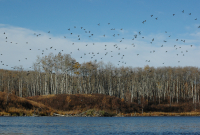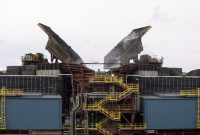On December 19th, 2022 the Kunming-Montreal Global Biodiversity Framework (GBF) was signed by 196 nations committed to taking urgent action against rapid biodiversity loss. All nations agreed to develop a biodiversity strategy to meet the goals and targets set out in the GBF, including the protection of thirty per cent of land and seas by 2030. The biodiversity strategy is the foundation of Canada’s renewed commitment to protect, preserve and regenerate nature, but as with climate policies we can expect a protracted fight with industry and some politicians to ensure our commitment to nature is being fulfilled.
Canada’s boreal wetlands are the ecosystem equivalent of Aladdin’s cave. These undisturbed wilderness areas are a treasure trove of biodiversity and a massive store of carbon that has been collected for thousands of years. They’re teeming with incredibly rich and vibrant life including birds, fish, mammals, insects, plants, soil, fungi and mosses. Canada’s northern wetlands are the crown jewels in a rich tapestry of biodiversity and ecosystem services.
One of Alberta’s largest wetland complexes is the McClelland Lake watershed, located in the heart of oilsands country north of Fort McMurray. The McClelland wetland complex is nestled between Suncor’s Fort Hills open pit mine and Imperial Oil’s Kearl mine, where 300,000 barrels of bitumen are produced each day in the excavated wasteland that was once a boreal forest.
The McClelland wetland features an extraordinary patterned fen that is an important stopover point and breeding ground for an abundance of migratory bird species. A patterned fen is characterized by alternating peat or moss ridges (called strings) and water-filled depressions (called flarks) that are perpendicular to the water flow.
The ridged terrain calms the water and the mix of chemical properties in the soil gives rise to a wide cross-section of vegetation and diverse plant communities. Fens are home to rare and uncommon species, including endangered woodland caribou and whooping cranes. This natural richness creates a landscape of spirit-lifting beauty that is respected and treasured by local Indigenous communities.
Although there are many similar fens in the eastern foothills of Alberta, the size of the McClelland wetland complex is significant. In a 2023 research paper by bryologist and peatland ecologist Dale H. Vitt, the wetland is estimated to be nearly 4,000 hectares with the patterned fen area being around 750 hectares — the size of 1,500 football fields.
Core samples taken for Vitt’s research revealed the wetland formed soon after glaciers retreated from the region 11,000 years ago. This was a time when peatlands were uncommon throughout the northern boreal regions of Canada. While other wetlands in Alberta have changed over the millennia, McClelland’s extreme-rich fens have been remarkably resilient with little change in the dominant species for thousands of years.
From a climate perspective, the wetland complex may store as much as 35 million tonnes of CO2. A study by the University of Lethbridge estimated that McClelland’s extreme-rich fen could potentially absorb 176 grams of carbon per square meter per annum, or over 4.5 kilotonnes of CO2 each year.
But perhaps the greatest value of the McClelland wetland complex is its paleoecological record that scientists can study to unlock the secrets of its resilience to climate change over the last 10,000 years. This knowledge may prove to be invaluable as climate change accelerates due to the burning of fossil fuels.
In 1996, the Alberta government was aware of the importance of this wetland and within its subregional integrated resource plan stated, “oilsands development using surface mining techniques is not permitted.” The McClelland wetland was officially off limits to resource development.
Two years later, the Koch Industries subsidiary TrueNorth Energy Corporation obtained mining leases that included the McClelland wetland area. At TrueNorth’s request, the resource plan was updated in 2002 to include a caveat that permitted surface mining as long as developers preserved, “the water table, water chemistry and water flow within limits as indicated by natural fluctuations to maintain ecosystem diversity and function.”
This opened the door for Suncor’s plan to “responsibly” develop half of the McClelland wetland by constructing a 14-kilometer-long wall through the middle of this sensitive ecosystem. Apparently, as long as the remaining half of the ecosystem functions within some ill-defined limits, then the original intent of the government’s guidelines will be met. A good deal of creative license is required to turn the phrase “not permitted” into “we’ll only destroy half.”
The feasibility of Suncor’s plans to protect the remaining wetland has been challenged by the Alberta Wilderness Association (AWA) and a formal request has been submitted to the Alberta Energy Regulator (AER) asking them to reconsider and revoke the approval of Suncor’s operational plan. AWA’s Phillip Meintzer states, “AWA’s vision is for the entire 330 km² McClelland watershed to be designated a permanent protected area including Indigenous co-management, and its two patterned fens designated Ecological Reserves or other stringent protection compatible with the exercise of Indigenous rights.”
Suncor’s vision for the wetland complex has a more self-serving focus involving revenue, corporate profits and executive bonuses. AER has supported this vision based on the short-sighted assumption that billions in resource royalties are more important to the province than an irreplaceable 10,000 year old wetland.
You might think that 200,000 barrels of bitumen extracted from the existing Fort Hills mine each year for the next 50 years would be enough wealth generation to satisfy Suncor executives and float provincial budgets. But the allure of another billion barrels of bitumen is hard to resist — and there is likely no turning back after Suncor spent over a billion dollars to secure 100 per cent ownership of Fort Hills and the McClelland Lake leases.
This is the very reason why we need a federal strategy to protect biodiversity with legislation to guarantee our most biodiverse and carbon-rich ecosystems are legally protected. The federal government has committed to creating a nature accountability bill in 2024 as part of its GBF commitment. This legislation needs to include corporate and governmental accountability while having teeth to punish corporations and provincial legislators that break federal law.
Without this kind of accountability, oilsands companies such as Suncor and Imperial Oil will continue to use their formidable influence to change the rules and exploit precious ecosystems in the pursuit of never-ending growth.
Like a cancerous tumour, resource companies will consume and contaminate surrounding watersheds and forests while releasing enough CO2 to rapidly warm our planet and cause further havoc with the biosphere.
The McClelland Lake wetland complex is just one of many ecosystems that need our protection, but it is symbolic due to its ancient history and the tragic consequences of allowing it to be absorbed into the surface mining wasteland that is metastasizing through the region.
Rob Miller is a retired systems engineer, formerly with General Dynamics Canada, who now volunteers with the Calgary Climate Hub and writes on behalf of Eco-Elders for Climate Action, but any opinions expressed in his work are his own.






Comments
1) Rob Miller, thanks for being an engineer who gets it. I'm always shocked at how many "sciencey" deniers are engineers. (They come third after physicists and geologists, according to my informal research, with geophysicists the most prolific deniers. I figure it's because they're all sciences with little to no connection to ecology and ecological literacy, so this was a nice surprise.)
2) This says it all: "A good deal of creative license is required to turn the phrase 'not permitted' into 'we’ll only destroy half.'" Does that make anyone else feel like running down the street screaming like a crazed person? Do corporations and governments / politicians / bureaucrats ever listen to themselves?
3) Re: "But perhaps the greatest value of the McClelland wetland complex is its paleoecological record that scientists can study to unlock the secrets of its resilience to climate change over the last 10,000 years." The strange thing about that (besides that the greatest value surely is to all the living beings living within and adjacent to the wetland) is that the last 10,000 years have been — even globally (with regional blips) — quite climatically stable (at a steady ±280 parts per million of CO2 atmospheric concentration), which is why it was during the last 10,000 years that we developed agriculture and food security.